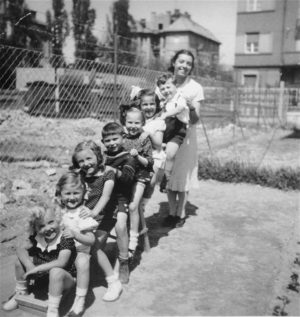‘They say a picture can tell a thousand words’, the story behind the cover photograph – by Dr Eleni Karayianni (co-author)
The story behind the photograph:
The image we have chosen for our new ‘Understanding the Holocaust: How and why did it happen?’ textbook’s cover portrays a group of children posing with their teacher on a seesaw in a pre-school playground in Budapest, Hungary. Taken in 1938, the group is a mixture of Jewish and non-Jewish children.
Gyorgy (George) Pick is the boy seated closest to the teacher. He was born on March 28, 1934 in Budapest, to Jewish parents, Istvan and Margit Pick. After Hungary allied itself with Nazi Germany, Gyorgy’s father lost his job. Beginning in 1940, Istvan was conscripted into the Hungarian labour service. During his absence, Gyorgy and his mother remained in their home in Budapest and Gyorgy attended a Jewish school. In June 1944 they were forced to move to one of the specially designated “yellow star” houses in the city.
In September 1944 Istvan’s battalion moved to Budapest and in October his commander warned the members of his unit that they would be sent to Germany the following day. During the 24-hour leave the men were given prior to their transfer, Istvan went into hiding. He sought the help of a former Hungarian business associate, Gyorgy Gyekis, who sent him to a textile factory. The factory was supposedly manufacturing uniforms for the Hungarian army, but in actuality, had ceased production and was used as a hiding place for approximately 170 Jews, including close to 100 women and children. The factory was established by Imre Kormos (Kohn), a Hungarian Jew living on false papers. Kormos operated four factories where 1100 Jews were hidden.
In November 1944, one month after arriving at the factory, Istvan sent a message to Margit and Gyorgy telling them to join him. Shortly after the Picks were reunited in the factory, Kormos was betrayed to the Gestapo. The informer also disclosed the locations of three of Kormos’ four factories. Five armed members of the State Security Police raided the factory where the Picks were hiding. Fortunately, the Jews were able to evade arrest by bribing the police. Kormos was tortured for two days but he did not disclose the location of his fourth factory, thus giving those hidden there a chance to escape. He was sentenced to death, but managed to escape and survive the war.
A few days after the raid, Gyorgy was transferred with the rest of the children in his factory to a building under the protection of the International Red Cross. Because there was no food there, Gyorgy left and rejoined his parents in the textile factory. Soon after his escape, there was an Arrow Cross raid on the Red Cross safe house, during which the children were rounded-up and shot on the banks of the Danube.
Gyorgy and his parents remained at the factory until December when they were brought to the new central ghetto. They were liberated by the Soviets one month later on January 18, 1945. Though Gyorgy and his parents survived, 161 members of their extended family perished in the Holocaust. The Picks immigrated to the United States in 1956. The image was donated by Gyorgy to the United States Holocaust Memorial Museum. No information exists about what happened to the rest of the children in the photograph.
United States Holocaust Memorial Museum, Photograph Number: 14679
Why we chose this image:
Many different considerations went into the choosing of this image as the textbook’s cover. These considerations were rooted in our educational principles and reflected the pedagogical approach we employed throughout the book.
We wanted to use a different image than those usually associated with the Holocaust. We feel that the image of children – both Jewish and non-Jewish – in happy times invites consideration of who the Jewish people were and their place in broader European life before the war. Also, it is a ‘regular’ image, the kind of which all of us have as memories from our childhood or our children’s early years in school. It is a photograph taken not to be used as evidence of any kind, but as a tender memoir. At the same time, the viewers’ knowledge of what happened after the image was taken makes confronting the children’s innocent smiling faces incredibly disturbing and saddening. This knowledge invites viewers to look again at the image, to think about their relationship and response to it, and to consider what they ‘do’ with their knowledge of this dark and traumatic history.
The image acts as a gateway, an access point to a tragic and compelling story of devastation and loss. All 161 members of Gyorgy’s extended family were murdered; thereby creating an indelible void at the heart of Gyorgy’s life. Such personal devastation was, of course, experienced by millions of others and magnified on a continental scale. In this way, there is added significance in how Gyorgy’s story takes place in Hungary where the actions of the Nazis and their collaborators between May and July 1944 spoke of a fervent determination to obliterate Jewish life.
But the image speaks more than a tragic story. Significantly, it also tells a story of incredible human perseverance, a remarkable story of rescue, resistance and survival.
*Teachers can learn more about our Centre authored, new research-informed KS3 history textbook, published by Hodder, and how to secure FREE class sets for their schools here: https://holocausteducation.org.uk/research/publications/understanding-holocaust-happen/


